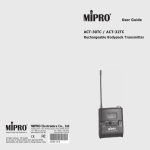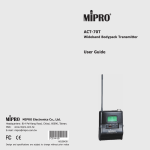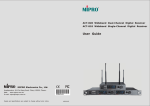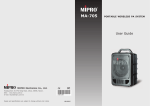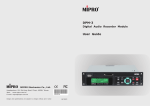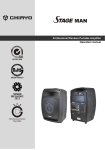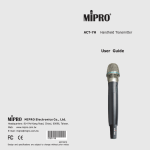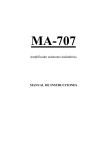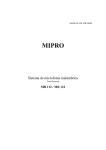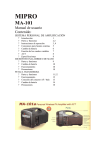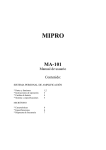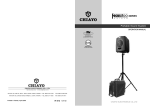Download User Guide
Transcript
Disposal Dispose of any unusable devices or batteries responsibly and in accordance with any applicable regulations. Disposing of used batteries with domestic waste is to be avoided! 2005-08-13 Batteries / NiCad cells often contain heavy metals such as cadmium(Cd), mercury(Hg) and lead(Pb) that makes them unsuitable for disposal with domestic waste. You may return spent batteries/ accumulators free of charge to recycling centres or anywhere else batteries/accumulators are sold. ACT-8H / ACT-8T DIGITAL WIRELESS MICROPHONE SYSTEMS By doing so, you contribute to the conservation of our environment! User Guide Electronics Co., Ltd. Headquarters: 814 Pei-Kang Road, Chiayi, 60096, Taiwan. Taipei office: 5, Lane 118, Sung-teh Road, 10075, Taipei, Taiwan. http://www.mipro.com.tw E-mail: [email protected] 2 CE2 6 3 Design & specifications are subject to change without prior notice C AS090715 WARNING IMPORTANT SAFETY INSTRUCTIONS 1. Read these instructions. 2. Keep these instructions. 3. Heed all warnings. 4. Follow all instructions. 5. Do not use this apparatus near water. 6. Clean only with a dry cloth. 7. Do not block any ventilation openings. Install in accordance with the manufacturer's instructions. 8. Do not install near any heat sources such as radiators, heat registers, stoves, or other apparatus (including amplifiers) that produce heat. 9. Do not defeat the safety purpose of the polarised or ground plug: A polarised plug has two blades with one wider than the other. The wide blade is provided for your safety. When the provided plug does not fit into your outlet, consult an electrician for replacement of the obsolete outlet. 1. FOR OUTDOOR USE: TO REDUCE THE RISK OF FIRE OR ELECTRIC SHOCK, DO NOT EXPOSE THIS APPARATUS TO RAIN OR MOISTURE. 2. UNDER WET LOCATION: Apparatus should not be exposed to dripping or splashing and no objects filled with liquids, such as vases should be placed on the apparatus. 3. SERVICE INSTRUCTIONS: CAUTION - These servicing instructions are for use by qualified service personnel only. To reduce the risk of electric shock, do not perform any servicing other than that contained in the operating instructions unless you are qualified to do so. This symbol indicates that dangerous voltage constituting a risk of electric shock is present within this unit. 10. Protect the power cord from being walked on or pinched particularly at plug, convenience receptacles, and the point where they exit from the apparatus. This symbol indicates that there are important operating and maintenance instructions in the literature accompanying this unit. 11. Only use attachments/accessories specified by the manufacturer. 12. Use only with a cart, stand, tripod, bracket, or table specified by the manufacturer, or sold with the apparatus. When a cart is used, use caution when moving the cart/apparatus combination to avoid injury from tip-over. 13. Unplug this apparatus during lightning storms or when unused for long periods of time. FCC Caution: To assure continued compliance, any changes or modifications not expressly approved by the party responsible for compliance could void the user's authority to operate this equipment. (Example - use only shielded interface cables when connecting to computer or peripheral devices). This device complies with Part 74 of the FCC Rules. Operation is subject to the following two conditions: 14. Refer all servicing to qualified service personnel. Servicing is required when the apparatus has been damaged in any way, such as power-supply cord or plug is damaged, liquid has been spilled or objects have fallen into the apparatus, the apparatus has been exposed to rain or moisture, does not operate normally, or has been dropped. (1) This device may not cause harmful interference, and (2) This device must accept any interference received, including interference that may cause undesired operation. 15. To reduce the risk of fire or electric shock, do not expose this apparatus to rain or moisture. IC 16. Apparatus should not be exposed to dripping or splashing and no objects filled with liquids should be placed on the apparatus. The user manual for the LPD shall contain the following or equivalent statements in a conspicuous position: 17. Use only with the battery specified by the manufacturer. "Operation is subject to the following two conditions: (1) this device may not cause interference, and (2) this device must accept any interference, including interference that may cause undesired operation of the device." 18. The power supply cord set is to be the mains disconnect device. Contents Handheld Wireless Microphone HANDHELD WIRELESS MICROPHONE KEY FEATURES ACT-8H DIGITAL WIRELESS HANDHELD MICROPHONE 1 PART NAMES AND FUNCTIONS 2 BATTERY REMOVAL AND INSTALLATION 3 PROPRIETARY DESIGN TO AVOID ACCIDENTAL POWER ON/OFF 4 TRANSMITTER LCD INTERFACE 5 WARNINGS 12 BODYPACK TRANSMITTER KEY FEATURES 13 PART NAMES AND FUNCTIONS 14 BATTERY REMOVAL AND INSTALLATION 15 TRANSMITTER LCD INTERFACE 16 WARNINGS 24 AF 4-PIN INPUT PIN CONFIGURATION 25 HIGH FREQUENCY BYPASS 26 KEY FEATURES: 24-bit audio quality and digital RF transmission. Proprietary encryption offers secure audio transmission, preventing unauthorised listening. Durable, rugged magnesium alloy housing. Anti-roll & anti-pop microphone capsule module with extremely low handling noise characteristics. LITHIUM-POLYMER BATTERY CHARGER Optional interchangeable microphone capsule modules available. PART NAMES AND FUNCTIONS 27 Bright LCD display shows working channel, battery status, input level and error codes. BATTERY CHARGER INSTRUCTIONS 28 WARNINGS 28 Integrated antenna provides maximum transmission efficiency and the patented coloured rear caps protect the on/off switch and allow easy visual channel identification. Built-in, detachable lithium-polymer (Li-Poly) battery pack can be recharged alone or together with the transmitter. The transmitter can be used continuously for up to 8 hours - the longest operational time of any digital series product on the market. Includes MIPRO's patented industry-standard ACT (Automatic Channel Targeting) channel set-up technology. 0 1 Handheld Wireless Microphone Handheld Wireless Microphone PART NAMES AND FUNCTIONS 1 BATTERY REMOVAL AND INSTALLATION 3 2 REMOVAL 4 (Figure 2) 5 Remove Insert 1. Power off the transmitter. 2. Remove the microphone capsule assembly 1 by unscrewing it in an anti-clockwise direction. 3. Rotate the rechargeable battery module 5 anti-clockwise to release it. 4. Gently pull out the battery module. 5. Insert the battery module into the battery charger for recharging. INSTALLATION 5 1. Insert the battery module 5 gently into the housing 2. Turn clockwise slowly until the battery module drops down into the housing. 3. When the battery drops down, turn the battery clockwise a little more to line up the dot on the module with the cut-out in the housing. This will lock the battery in place. 4. Replace the microphone capsule assembly 1 OFF SET MODE 6 10 7 8 11 9 NOTE: The battery will not make proper (Figure 1) contact internally if it is not securely locked in place. Incorrect insertion may result in inability to turn the transmitter on. 1 Top Grille: Protects detachable microphone capsule module and internal foam minimises breath, wind and POP noise. 2 Microphone Capsule Module: Detachable microphone capsule. 3 Housing: Houses transmitter PCB and battery compartment. 4 LCD Screen: Displays group, channel, gain, battery status, input SPL, other parameters and error codes. 5 Rechargeable Battery Module: Detachable Lithium-Polymer (Li-Poly) battery modules can be recharged individually or whilst fitted to the transmitter. 6 Power On-off Switch: Slide the power switch to the “ON” position for use or to the “OFF” position when not in use. 7 MODE: Function select button. Move dot on battery away from cutout on housing to remove battery module 8 SET: Parameter select button. 9 Colour Coded Protection Cap: Protects against accidental power on/off. Available in different colours for easy visual channel identification. 10 ACT Infrared (IR) Port: Receives setup data from the receiver to synchronise transmitter to receiver. 11 Battery Charging Contacts: Align correctly when placing transmitter into charging station. 2 Turn dot to align it with cutout on housing to secure battery module NOTE: When microphone is not in use, ensure it is switched off. The battery module can be recharged inside the transmitter or can be removed from the transmitter and charged stand-alone. 3 Handheld Wireless Microphone Handheld Wireless Microphone PROPRIETARY DESIGN TO AVOID ACCIDENTAL POWER ON/OFF TRANSMITTER LCD INTERFACE The patented rear protective cap serves two purposes: to provide easy visual channel identification and to protect accidental operation of the on/off switch by the user. Fully Lit LCD Display RF A AF B BT To remove Protective Cap: 1. Power OFF the transmitter. 2. Firmly grasp the cap and pull straight back. Do not rock the cap side to side when pulling it off. Parameter Display MODE button: Accesses 7 different parameters The LCD screen can display 7 transmitter parameters: Pull and remove rear cap GR--CH FREQ LOW--CU AF--SEN LIMIT ENCRYP POWER Install Protective Cap: 1. Power ON the transmitter. 2. Turn the cap 180 degrees and slide the cap back against the lower housing. 3. Make sure the cap covers the On/Off switch. 4. Caps are available in different colours for visual channel identification. Setup Instructions Press and release the MODE button 7 to select the required function. Press again for the next etc. Parameter value starts to flash once it is selected. Press the SET button 8 to modify the parameter value whilst it is flashing. To confirm the change, do not press any button for 5 seconds. When flashing stops, the parameter is saved and stored into memory. Turn rear cap 180 degrees and re-install the cap GR-CH Displays Group and Channel GR-CH text & numerics flash alternately NOTE: MIPRO recommends that the protective cap is always in place during use. RF RF AF BT BT AF Flashing stops when no buttons are pressed for 5 seconds. MODE 4 5 GR--CH Handheld Wireless Microphone Handheld Wireless Microphone Instructions: LOW-CU 1. Press ''MODE'' button until “GR---CH” parameter appears. It displays and flashes the currently programmed Group and Channel. Flashing stops after 5 seconds. 2. The Group and Channel can only be indicated. Group and Channel cannot be changed on the transmitter, only from the receiver via ACT. Low Frequency Cut-Off Screen flashing alternately NOTE: If a new frequency is programmed into the transmitter using the PC Software package, the display will flash alternately “GR- -CH / **- -**” as shown below. Actual Group and Channel numbers will not appear as the selected frequency is not part of the preset frequency set programmed into the transmitter. RF RF AF Press "SET" for "OFF" or "ON” BT RF BT AF AF BT Flashing stops when no button is pressed for 5 seconds. GR- -CH & **- -** Flashes alternately AF OFF RF RF BT MODE BT AF LOW--CU ON SET Instructions: FREQ Displays Transmitter Frequency 1. Press ''MODE'' button until “LOW-CU” parameter appears. It displays and flashes the currently programmed “ON” or “OFF” setting. 2. Press the “SET” button to change setting. Setting is changed and saved automatically after 5 seconds. Flashes alternately AF NOTE: The Low Cut-off is set by default in the “OFF” position. When turned “ON'', the frequency response below 100Hz will decrease about 4dB with a slope of -6dB/Octave. RF RF BT BT AF (The listed frequency is shown in ''MHz'') MODE FREQ Instructions: 1. Press the ''MODE'' button until “FREQ” parameter appears. It displays and flashes “FREQ” and the currently programmed actual working frequency. Flashing stops after 5 seconds. 2. The frequency can only be indicated. Frequency cannot be changed on the transmitter, only from the receiver using via ACT. NOTE: Transmitter frequency is synced automatically via the receiver by pressing the “ACT” button. 6 7 Handheld Wireless Microphone AF-SEN Handheld Wireless Microphone Input Audio Sensitivity LIMIT Screen flashing alternately Input Limiter Screen flashing alternately Press "SET" to select gain in 6dB steps RF RF RF RF RF RF AF BT AF Press "SET" for "OFF" or "ON” BT AF BT BT AF AF BT BT AF Flashing stops when no button is pressed for 5 seconds. Flashing stops when no button is pressed for 5 seconds. OFF MODE MODE AF--SEN 0 DB 6 DB 12 DB SET SET SET LIMIT ON SET Instructions: Instructions: 1. Press “MODE” until “AF--SEN” function appears; the display showing the current status will be flashing and is ready to be modified. 2. Each press of the ''SET'' button increases the dB value by 6dB to a maximum of 12dB (then reverts back to 0dB). Setting is changed and saved automatically after 5 seconds. 0 DB 6 DB 1. Press ''MODE'' button until “LIMIT” parameter appears. It displays and flashes the currently programmed “ON” or “OFF” setting. 2. Press the “SET” button to change the setting. Setting is changed and saved automatically after 5 seconds. NOTE: Default factory setting is “OFF”. When ''ON'', the maximum output of the receiver is limited to 1 Volt. 12 DB ENCRYP ENCRYPTION ON NOTE: 1. Default factory setting is “0dB”. 2. The higher the gain setting, the lower the dynamic range for signal input. At higher settings the unit can be more susceptible to audio noise interference. 3. 0dB or 6dB is the general setting. 4. At 0dB, 125dB maximum SPL can be input to the transmitter. MODE ENCRYP OFF Instructions: 1. Press ''MODE'' button until “ENCRYP” parameter appears. It displays and flashes the currently programmed “ON” or “OFF” setting. NOTE: The encryption setting can only be indicated. Encryption cannot be changed on the transmitter, only from the receiver and synced using the ACT button. 8 9 Handheld Wireless Microphone POWER Handheld Wireless Microphone ERR Message: POWER SELECTION Screen flashing alternately Press SET button once for POW-LO: Power Low Press SET button again for POW-HI: Power High RF RF BT AF When "ERR" appears in the display it indicates that an operational error has occurred. Please refer to the following codes to diagnose which error you are experiencing. ROM-ER Transmitter does not have the initial data, thus it is completely dead and cannot be programmed. Refer to your dealer. ERROR1 RF circuitry failure. Frequency cannot be programmed. Refer to your dealer. NO----OR3 The frequency you want to program is above the switching bandwidth of the transmitter. Use a receiver with an appropriate, matching frequency band. (Whilst the error message is showing, the microphone is still operating and its frequency remains unchanged. To clear the displayed “ERR“ message, switch the handheld transmitter off and on again.) NO----OR4 The frequency you want to program is below the switching bandwidth of the transmitter. Use a receiver with an appropriate, matching frequency band. (Whilst the error message is showing, the microphone is still operating and its frequency remains unchanged. To clear the displayed “ERR“ message, switch the handheld transmitter off and on again.) RF BT AF BT AF Flashing stops when no button is pressed for 5 seconds. POW--HI MODE POWER POW--LO Instructions: 1. Press ''MODE'' button until “POWER” parameter appears. It displays and flashes the currently programmed “POW-HI” or “POW-LO” setting. 2. Press the “SET” button to change the setting. Setting is changed and saved automatically after 5 seconds. NOTE: POW-HI selects 50mW transmitter power output. POW-LO selects 10mW transmitter power output. Set appropriate power to meet local regulations. Use the lower power setting to conserve batteries. Where possible always use low power for hand held transmitters. The low power setting will result in less intermodulation issues when using multiple hand helds in larger systems. BT PO-OFF When the power switch is moved to the “Off” position, the LCD will show "PO-OFF" (for Power Off) first and then the system will shut down and no further messages will be displayed. TRANSMITTER BATTERY METER BT BT 100% 90% BT BT BT BT 80% 40% 10% 0% The LCD battery meter is shown only when the transmitter is powered on. The meter gives a percentage (%) indication of remaining battery life, as shown above. Replace with a new, fully charged battery module (or place the mic into the charging station) when battery meter indication falls to 10% (1 level remaining). If an under voltage condition continues, the LCD will show "PO-OFF" and the system will shut down to prevent the battery becoming overly discharged. 10 Power Off : 11 Handheld Wireless Microphone Bodypack Transmitter WARNINGS 1. MIPRO recommends inserting the complete wireless transmitter into the battery charger for charging. Charging the battery module by always removing it is not recommended. In-situ charging will also prolong the life of the contact springs on the battery module. 2. The ACT-8H has an integrated antenna at the end of the rear housing (covered by the coloured protective cap). Performers should avoid holding the microphone over or near the antenna area as this will degrade transmission efficiency. Severe degradation will occur if the performer directly covers up the antenna section with both hands. 3. 4. ACT- 8T DIGITAL WIRELESS BODYPACK TRANSMITTER KEY FEATURES: 24-bit audio quality and digital RF transmission. Many performers tend to hold the microphone by the top grille. Unfortunately, this position seriously degrades both the sound quality and directionality of the microphone capsule. Even the most expensive microphones will have their original sound quality compromised by this method. Grabbing a microphone by the grille will isolate the capsule's acoustic resonance circuit and may change the capsule's resonant frequency. This results in inferior performance in both frequency response and directionality. In addition, a palm's sound-focusing effect will tend to strengthen resonances in certain frequencies and make the microphone sound bad. Proprietary encryption offers secure audio transmission, preventing unauthorised listening. Rugged, lightweight magnesium-alloy housing. Proper technique is necessary when using directional microphones because the distance between the microphone and the mouth has a significant impact on sensitivity and performance. There is an inverse relationship between microphone sensitivity and the distance from the mouth to the microphone. Consequently, performers with a ''weaker'' voice cannot expect to hold the microphone too far away from their mouth and compensate by turning up the amplifier volume to increase the sound level as this can easily cause premature feedback. In contrast, performers with a ''stronger' voice should not hold the microphone too close as this can result in distortion by causing the input gain stage to overload. Removable, flexible antenna, toggle power switch and XLR input connector. Bright LCD display shows working channel, battery status, input level, setup parameters and error codes. Detachable lithium-polymer (Li-Poly) battery pack can be recharged alone or together with the transmitter. The transmitter can be used continuously for up to 8 hours --- the longest operational time of any digital series of products on the market. Furthermore, a large-diaphragm directional microphone has a very distinct proximity effect. When the microphone is close to the mouth, bass response increases as the distance from the mouth to the mic reduces. Therefore, if a performer's voice is low in bass, they can hold the microphone closer and use the proximity effect to help compensate for the lower bass level. Conversely, if a performer's voice is too heavy in the bass register, increasing the distance between the microphone and their mouth will decrease the proximity effect and reduce the bass response, thus making their voice become clearer and brighter. 5. Reversible belt clip enables normal or upside-down wearing position to suit user¡¦ s preference. Includes MIPRO's patented industry-standard ACT (Automatic Channel Targeting) channel set-up technology. It is recommended to keep the grille and sponge windscreen clean to avoid any substance affecting the proximity effect of the microphone. FCC ID: M5X-ACT8H THIS DEVICE COMPLIES WITH PART 74 OF THE FCC RULES AND RSS-123 Issue1 OF CANADA. OPERATION IS SUBJECT TO THE FOLLOWING TWO CONDITIONS: (1) This device may not cause interference. (2) This device must accept any interference, including interference that may cause undesired operation of the device. This equipment complies with FCC RF radiation exposure limits set forth for an uncontrolled environment. 12 13 Bodypack Transmitter PART NAMES AND FUNCTIONS Bodypack Transmitter BATTERY REMOVAL AND INSTALLATION REMOVAL Press the battery retainer to release the battery pack 1 2 Push downward 3 4 9 10 5 Push outward 6 Step 1 7 11 12 8 AF Input Socket: Connects to Lavalier, headset microphone or to guitar cable. (See 5 different pin configurations for the 4-pin TA4F, mini-XLR AF input connector on page 25). 2 Power On-off Switch: Slide the power switch to the •gON•h position for use or to the •gOFF•h position when not in use. 3 Transmitting Antenna:Detachable 1/4λ antenna. 4 ACT Infrared (IR) Port: Receives setup data from receiver to synchronise transmitter to receiver. 5 LCD Screen: Displays group, channel, gain, battery status, input SPL, other parameters and error codes. SET: Parameter select button. 7 MODE: Function select button. Step 3 1. Power off the transmitter. 2. Remove the belt clip 3. Press the battery retainer with one finger, then pull down gently with other hand to remove the battery module. 4. Insert the battery module into the battery charger for recharging. (Figure 1) 1 6 Step 2 8 Housing: Houses transmitter PCB and battery compartment. 9 Battery Module Retainer/Release: Press firmly to release battery module. INSTALLATION Place battery pack and align with guide rails Step 1 Push upward Step 2 Step 3 10 Rechargeable Battery Module: Detachable Lithium-Polymer (Li-Poly) battery module can be recharged alone or together with the transmitter. 2. Push the battery pack upwards until a ¡§click¡¨ is heard. 11 Belt clip: Reversible. Can be worn normally or upside-down. 3. Check that the battery is locked firmly in place then re-attach the belt clip. 12 Battery Charging Contacts: Align correctly when placing transmitter into charging station. 14 15 1. Locate the battery pack back on the transmitter. Bodypack Transmitter Bodypack Transmitter TRANSMITTER LCD INTERFACE Instructions: Fully Lit LCD Display 1. Press ''MODE'' button until “GR---CH” parameter appears. It displays and flashes the currently programmed Group and Channel. Flashing stops after 5 seconds. 2. The Group and Channel can only be indicated. Group and Channel cannot be changed on the transmitter, only from the receiver via ACT. RF A AF B BT NOTE: If a new frequency is programmed into the transmitter using the PC Software package, the display will flash alternately “GR- -CH / **- -**” as shown below. Actual Group and Channel numbers will not appear as the selected frequency is not part of the preset frequency set programmed into the transmitter. GR- -CH & **- -** Flashes alternately Parameter Displays MODE button: access to 9 different parameters RF RF The LCD screen displays 9 transmitter parameters. AF GR--CH FREQ LOCK AF--SEN PHASE LOW--CU POWER BT BT AF LIMIT FREQ ENCRYP Displays Transmitter Frequency Flashes alternately Setting Instructions Press and release the MODE button 7 to select the required function. Press again for the next etc. Parameter value starts to flash once it is selected. Press the SET button 8 to modify the parameter value whilst it is flashing. To confirm the change, do not press any button for 5 seconds. When flashing stops, the parameter is saved and stored into memory. RF RF AF BT BT AF (The listed frequency is shown in ''MHz'') GR-CH Displays Group and Channel GR-CH text & numerics flash alternately MODE FREQ RF RF Instructions: AF BT BT AF 1. Press the ''MODE'' button until “FREQ” parameter appears. It displays and flashes “FREQ” and the currently programmed actual working frequency. Flashing stops after 5 seconds. 2. The frequency can only be indicated. Frequency cannot be changed on the transmitter, only from the receiver using via ACT. Flashing stops when no buttons are pressed for 5 seconds. MODE GR--CH NOTE: Transmitter frequency is synced automatically via the receiver by pressing the “ACT” button. 16 17 Bodypack Transmitter LOW-CU Low Frequency Cut-Off BT Screen flashing alternately Press "SET" for "OFF" or "ON” RF RF BT AF BT AF BT AF Instructions: OFF LOW--CU RF Flashing stops when no button is pressed for 5 seconds. Flashing stops when no button is pressed for 5 seconds. MODE BT AF BT Press "SET" to select gain in 10dB steps RF RF RF AF Input Audio Sensitivity AF-SEN Screen flashing alternately AF Bodypack Transmitter 1. 1.Press “MODE” until “AF--SEN” function appears; the display showing the current status will be flashing and is ready to be modified. 2. Each press of the ''SET'' button increases the gain in 10dB steps to a maximum of 30dB (then reverts back to 0dB). ON SET Instructions: 1. Press ''MODE'' button until “LOW-CU” parameter appears. It displays and flashes the currently programmed “ON” or “OFF” setting. 2. Press the “SET” button to change setting. Setting is changed and saved automatically after 5 seconds. MODE AF--SEN 0 DB 10 DB 20 DB 30 DB SET SET SET SET NOTE: The Low Cut-off is set by default in the “OFF” position. When turned “ON'', the frequency response below 100Hz will decrease about 4dB with a slope of -6dB/Octave. NOTE: Default factory setting of input sensitivity is 0dB. The higher the gain setting, the lower the dynamic range available and consequently will also lower the signal to noise ratio. At 0dB, the maximum input signal is 1Vrms; thus, do not exceed this level. 18 19 Bodypack Transmitter LIMIT Bodypack Transmitter Input Limiter POWER Screen flashing alternately Screen flashing alternately Press "SET" for "OFF" or "ON” RF RF POWER SELECTION RF RF RF AF BT Press SET button once for POW-LO: Power Low Press SET button again for POW-HI: Power High BT AF AF RF BT BT AF Flashing stops when no button is pressed for 5 seconds. BT AF BT AF Flashing stops when no button is pressed for 5 seconds. OFF POW--HI MODE LIMIT MODE ON POWER POW--LO SET Instructions: Instructions: 1. Press ''MODE'' button until “POWER” parameter appears. It displays and flashes the currently programmed “POW-HI” or “POW-LO” setting. 2. Press the “SET” button to change the setting. Setting is changed and saved automatically after 5 seconds. 1. Press ''MODE'' button until “LIMIT” parameter appears. It displays and flashes the currently programmed “ON” or “OFF” setting. 2. Press the “SET” button to change the setting. Setting is changed and saved automatically after 5 seconds. NOTE: POW-HI selects 50mW transmitter power output. POW-LO selects 10mW transmitter power output. Set appropriate power to meet local regulations. Use the lower power setting to conserve batteries. However, it is normal to use the higher power setting for body packs due to the degradation of signal power caused by antenna proximity to the body. For body packs, best performance is achieved using the high power setting unlike the hand held where the lower power setting generally yields better results. NOTE: Default factory setting is “OFF”. When ''ON'', the maximum output of the receiver is limited to 1 Volt. ENCRYP ENCRYPTION PHASE Press SET button once for AF-NEG Press SET button once for AF-POS Screen flashing alternately ON MODE AF INPUT PHASE ENCRYP RF RF OFF AF Instructions: BT RF BT AF AF BT Flashing stops when no button is pressed for 5 seconds. 1. Press ''MODE'' button until “ENCRYP” parameter appears. It displays and flashes the currently programmed “ON” or “OFF” setting. NOTE: The encryption setting can only be indicated. Encryption cannot be changed on the transmitter, only from the receiver and synced using the ACT button. MODE 20 21 AF--POS AF has positive phase AF--NEG AF has negative phase PHASE Bodypack Transmitter Bodypack Transmitter Instructions: BT TRANSMITTER BATTERY METER 1. Press ''MODE'' button until “PHASE” parameter appears. It displays and flashes the currently programmed “AF-POS” or “AF-NEG” setting. 2. Press the “SET” button to change setting. Setting is changed and saved automatically after 5 seconds. BT NOTE: The Phase function provides users with an audio phase reversal option. The normal setting is AF-POS. When using 2-wire condenser microphones it is sometimes necessary to invert the audio phase to ensure proper alignment with other mics in the system. LOCK Screen flashing alternately AF AF BT BT BT 40% 10% 0% Press SET for YES or NO RF BT BT 80% The LCD battery meter is shown only when the transmitter is powered on. The meter gives a percentage (%) indication of remaining battery life, as shown above. Replace with a new, fully charged battery module (or place the mic into the charging station) when battery meter indication falls to 10% (1 level remaining). If an under voltage condition continues, the LCD will show "PO-OFF" and the system will shut down to prevent the battery becoming overly discharged. PARAMETER LOCK RF BT 100% 90% ERR Message: RF BT AF When "ERR" appears in the display it indicates that an operational error has occurred. Please refer to the following codes to diagnose which error you are experiencing. BT Flashing stops when no button is pressed for 5 seconds. ROM-ER Transmitter does not have the initial data, thus it is completely dead and cannot be programmed. Refer to your dealer. ERROR1 RF circuitry failure. Frequency cannot be programmed. Refer to your dealer. NO----OR3 The frequency you want to program is above the switching bandwidth of the transmitter. Use a receiver with an appropriate, matching frequency band. (Whilst the error message is showing, the microphone is still operating and its frequency remains unchanged. To clear the displayed “ERR“ message, switch the handheld transmitter off and on again.) NO----OR4 The frequency you want to program is below the switching bandwidth of the transmitter. Use a receiver with an appropriate, matching frequency band. (Whilst the error message is showing, the microphone is still operating and its frequency remains unchanged. To clear the displayed “ERR“ message, switch the handheld transmitter off and on again.) Instructions: 1. Press ''MODE'' button until “LOCK” parameter appears. It displays and flashes the currently programmed “NO” or “YES” setting. 2. Press the “SET” button to change setting. Setting is changed and saved automatically after 5 seconds. NOTE: When in LOCK mode, all parameters are locked and cannot be changed including powering on & off. The “MODE” button is still able to select parameters but no changes will be possible (other than selecting LOCK and then using SET again to unlock the device). To power off the transmitter when the LOCK function is enabled, the LOCK setting needs to be reset to the “NO” position. Note that a sudden loss of power (such as a battery becoming completely discharged or removal of the battery) will de-activate the LOCK function. PO-OFF Power Off : When the power switch is moved to the “Off” position, the LCD will show "PO-OFF" (for Power Off) first and then the system will shut down and no further messages will be displayed. 22 23 Bodypack Transmitter Bodypack Transmitter WARNINGS AF 4-PIN INPUT PIN CONFIGURATION 1. Adjust the pack input gain to the appropriate input level (The body pack gain needs to be set to 0dB when using an electric guitar). 2. 4-pin Connector: Before making any connections power down the transmitter to prevent damage to the transmitter, receiver or speaker system. Carefully align and insert the 4-pin plug into the connector according to the instructions below and tighten the locking ring (on Mipro mini-XLR only) in a clockwise direction as illustrated in Figure 2. Then power the unit up again. 3. If the transmitter is on with nothing connected to the AF input socket, the system may generate unwanted noise. Always ensure the input cable is connected before turning the pack on. 4. Power off the transmitter before disconnecting the input cable. 2-Wire Electret Condenser Microphone Capsule AUDIO Headset 2 4 1 3 2 3 4 3-Wire Electret Condenser Microphone Capsule SHIELD Capsule Connector PIN 1 SHIELD The cutout on the connector must match the indentation on the socket when inserting. PIN 1 2 AUDIO 4 1 3 BIAS 3 2 4 Lavalier Dynamic Microphone 2 1 SHIELD PIN 1 3 2 AUDIO 4 1 3 2 3 4 Electric Guitar SHIELD PIN 1 2 AUDIO 4 1 3 2 3 4 (Figure 2) Line-in (impedance 8KΩ attenuation 10dB) SHIELD AUDIO PIN 1 2 3 4 24 25 4 1 3 2 MP-8 Lithium-polymer Battery Charger Bodypack Transmitter HIGH FREQUENCY BYPASS 1. PART NAMES AND FUNCTIONS When other microphones are in use, some changes may be needed to another microphone before adding it to the system in order to avoid high frequency instability. Refer to the diagrams below. 2 3 2. When high frequency radio waves get into the audio path they can sometimes cause interference. The effect of this is generally persistent noise or degradation of the overall frequency response. In an effort to prevent these external factors affecting audio quality, a 330pF bypass capacitor can be added to the capsule as shown in diagrams (1) and (2). If this method is not possible, another option is to add a bypass capacitor on the 4-pin mini-XLR connector as shown in diagrams (3) and (4). 1 4 5 6 7 (Figure 1) **The Best Method (1) Connect to two-wire condenser capsule Add 330pF bypass capacitor (2) Connect to three-wire condenser capsule Add 330pF bypass capacitor 1 Power Indicator: Green light illuminated indicates DC power is on. 2 Transmitter Charger Slot: Charges one handheld or one body pack transmitter. Note that when a transmitter is charging you may also charge a battery pack (either handheld or body pack type) at the same time in the front slot. (See Figure 2) 3 Transmitter Charging Indicator: (a) Red light illuminated indicates battery is charging. (b) Green light illuminated indicates transmitter battery is fully charged (1~ 4 hours). 4 Battery Pack Charger Slot: Charges one handheld or one body pack transmitter battery. (See Figure 3) 5 Battery Module Charging Indicator: (a) Red light illuminated indicates battery is charging. (b) Green light illuminated indicates battery is fully charged (1~ 4 hours). **Alternate Method (3) Connect to two-wire condenser capsule (4) Connect to three-wire condenser capsule Add 330pF bypass capacitor 2 4 1 DC power supply input (12V DC 1.25A). 4 1 3 (Figure 2) 3 3 2 3 Housing keyways allow two battery chargers to be mechanically connected together. 7 PIN 1 PIN 1 2 6 (Figure 3) 2 4 4 Add 330pF bypass capacitor FCC ID: M5X-ACT8T THIS DEVICE COMPLIES WITH PART 74 OF THE FCC RULES AND RSS-123 Issue1 OF CANADA. OPERATION IS SUBJECT TO THE FOLLOWING TWO CONDITIONS: (1) This device may not cause interference. (2) This device must accept any interference, including interference that may cause undesired operation of the device. This equipment complies with FCC RF radiation exposure limits set forth for an uncontrolled environment. Transmitter Charging 26 27 Module Charging MP-8 Lithium-polymer Battery Charger Note BATTERY CHARGER INSTRUCTIONS 1. Plug the provided DC power supply into an AC outlet (100-240VAC) and attach the 4. battery charging station as shown in figure . 2. Insert the transmitter or battery module into the appropriate charging slot observing correct polarity. (Figure 4) WARNINGS 1. Use only the supplied MIPRO power supply with the charging station to avoid voltage problems. If the voltage to the charger is too high, it may damage the charger, rechargeable batteries or any connected transmitters! MIPRO recommend a 12V regulated 1.25A DC power supply. 2. The transmitter must be switched off when it is charging. 3. For safety reasons, do not use any other type of battery charger. 28 29


















